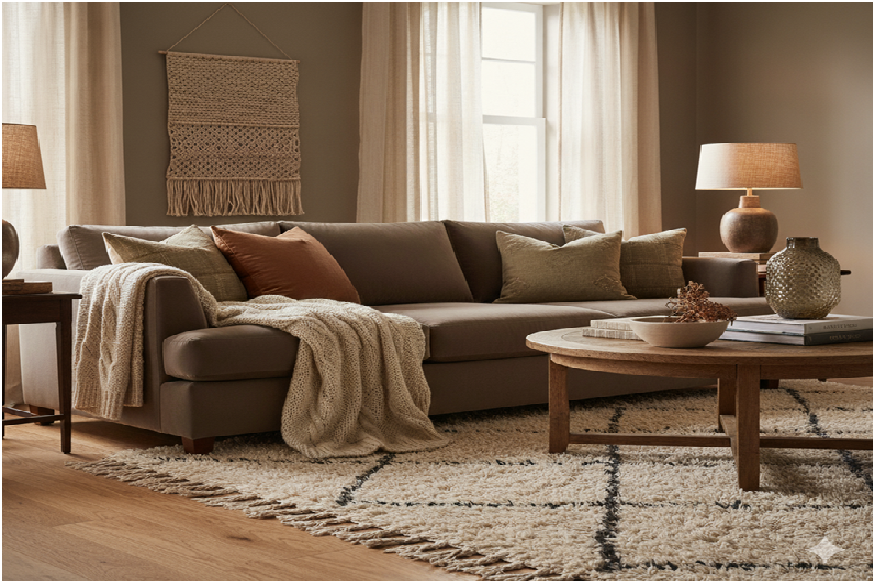
It is always believed that a beautiful home doesn’t come from expensive furniture or big changes. It’s the smaller, thoughtful details that make all the difference. When you walk into a home that feels warm and welcoming, there’s usually one secret behind it layering.
Layering is that subtle touch that makes a space feel alive. It’s the mix of textures, tones, and finishes that quietly create comfort. Designers love it, but honestly, anyone can do it once you start noticing how each element connects. A soft throw over a sturdy armchair, a woven rug under a glass table, or a few warm lights falling across a textured wall it’s these little combinations that give a room its soul.
A well-layered home doesn’t just look nice; it feels like it’s been loved for years. And that’s really what makes interiors stand out.
What Layering Really Means
Layering in decor isn’t about adding more things, it’s about creating depth. Think of it like dressing up for the weather. You start with the basics and then add what feels right. Maybe a jacket, maybe a scarf, something that adds comfort and balance. Your home works the same way.
You start with your base, your furniture, walls, and floors. That’s your blank canvas. Then come the layers: rugs, curtains, cushions, lamps, wall art, and decor. Each one adds warmth, softness, or contrast. Together, they tell a story.
When a room is layered well, your eyes don’t just land on one thing they travel. There’s a natural rhythm, a flow that feels easy. The room feels complete, not crowded.
The Beauty of Texture
If there’s one element that can completely change the feel of a room, it’s texture. Texture brings life, even when the color palette is simple. A room full of smooth, plain surfaces feels lifeless, but add a jute rug, a linen cushion, and a rough wooden table, and suddenly the space starts to breathe.
Mixing materials makes a home feel rich and real. Wood adds warmth, glass brings light, metal adds contrast, and fabrics bring softness. A wooden TV cabinet with glass or metal accents can beautifully showcase this blend, adding both function and style to your living room. Try combining smooth with rough it’s where the magic happens.
I always think of texture as the emotional side of design. A wool throw says comfort. A velvet chair whispers luxury. A cotton curtain feels light and free. When you touch these materials, they change how you feel about the space. That’s what layering is about creating those small emotional moments that make you pause and smile.
Tones and Colors: The Mood Makers
Colors can be tricky, but once you start layering tones instead of focusing on single shades, it all comes together. You don’t have to be a designer to do it right. Just start with a base color you love, something soft and calm and then play with lighter and darker versions of it.
For instance, cream walls, beige furniture, and tan accessories feel serene but not boring. Or you can go bold with contrasting a deep navy sofa against warm brown wood, or sage green with gold accents. The secret is balance. One color should take the lead; the rest should support it.
If you ever feel stuck, stick to neutrals and then bring color through cushions, artwork, or flowers. That one pop of coral or teal can completely shift the mood without needing a full makeover. Colors should move through the room naturally, not fight for attention.
How to Start Layering at Home
Here’s something I’ve learned: layering isn’t done in a day. It grows with time, just like how you collect memories and moments.
Start with the big things first. Your sofa, wooden double bed, or dining table will always be the foundation. Once you’ve got those, slowly add texture, maybe a rug that feels soft under your feet, or a pair of curtains that let the light fall gently in the mornings.
Then move on to personal touches. A few books, a small plant, maybe a photo that makes you happy these are the things that make your space yours. Don’t rush it. Shift things around, see what feels right. Sometimes you’ll find the perfect spot for something by accident.
Lighting is one layer people often forget, but it changes everything. Use a mix of lights, one that brightens, one that softens, and one that highlights. Lamps, candles, or even fairy lights can bring warmth in ways paint never can.
And most importantly, let your space breathe. You don’t have to fill every corner. A little empty space gives balance to everything else.
Creating a Space That Feels Like You
At the end of the day, layering isn’t about following rules, it’s about listening to what feels right. A home layered with care doesn’t shout for attention; it just quietly feels right.
Maybe you like mixing old with new vintage chairs with a sleek side table. Or maybe you love keeping things soft and neutral with just a hint of color. Adding a beautifully crafted mandir for home can also bring a touch of tradition and serenity to your space. Whatever your style, layering helps it shine through naturally.
Your home should make you feel something when you walk in. It should smell familiar, look warm, and feel like you belong. That’s what happens when you layer thoughtfully you create a home that doesn’t just look designed but one that feels genuinely loved.
Final Thought
Layering is an art, yes, but it’s also instinctive. You don’t need perfect color charts or design training, you just need a sense of what feels good. Mix textures, play with tones, and add details that make you smile. That’s all it takes to turn a plain room into a beautiful, comforting space that tells your story.
Because in the end, it’s not about perfection. It’s about warmth, comfort, and the quiet kind of beauty that makes a house feel like home.
